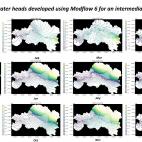Manikandan Shanmugarajasekaran, Ph.D. Candidate 37th cycle, University of Trento, DICAM
Megadroughts pose significant challenges to groundwater resources, affecting water availability, quality, and sustainability. The prolonged and severe drought conditions result in reduced groundwater recharge and increased demand, leading to the depletion of groundwater reserves.
Our research primarily centers on examining how droughts affect groundwater resources. Our focus is on investigating the recovery process of aquifers after experiencing prolonged droughts, specifically megadroughts. The research will particularly assess two key impacts: the time it takes for the water table to recover and the base flow of rivers. The inspiration for this study came from the observation that a significant Australian aquifer's recovery from a severe drought was slower than anticipated. The reasons behind this delayed recovery remain uncertain, prompting us to address them through modeling techniques.
Currently, we are developing the machinery by using the test case basin (Intermediate basin in India). Using the developed machinery, we will analyse the mechanism of groundwater recovery after megadroughts by developing the regional model (megadroughts affected regions as well as regions that are prone to megadroughts). Our vision is to develop a representative numerical subsurface transient flow model (1D vertical unsaturated flow and 3D groundwater flow) for the Ganga River basin, India (area of around 1 million sq. km and supports the population of half a million) by Modflow 6 using flopy in a python environment. We will apply statistical methods for creating synthetic scenarios by increasing the probability of the occurrence of droughts in terms of consecutive years (create a series of very dry years). We will understand the depletion and recovery of groundwater by incorporating the synthetic scenario equivalent to Megadrought in the developed model. We will incorporate the anticipated climate change scenarios into the developed model and simulate the groundwater flow and quantify the effect of climate change on groundwater resources.
Through this research, we may gain insights into the groundwater depletion and recovery mechanism of the basin under long-term droughts, which results in water scarcity and threatens food security and ecological balance. In addition, by using the same developed model, we will understand the status of groundwater in the basin concerning climate change scenarios, enabling us to implement better water management strategies.

